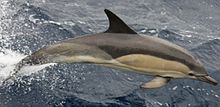Despite its name, the common dolphin is not the dolphin of popular imagination; that distinction belongs to the bottlenose dolphin (genus Tursiops) due to its widespread use in marine parks and its appearance in the television series Flipper.[1] However, this dolphin was the most frequently represented in the art and literature of ancient Greece and Rome.[2]

Physical characteristics
Both common dolphin species are medium-sized; adults range between 1.9 and 2.5 m (6.2 and 8.2 ft) long, and can weigh between 80–235 kg (176–518 lb), although the range between 80–150 kg (180–330 lb) is more common.[3] Males are generally longer and heavier.[3] The color pattern on the body is unusual. The back is dark and the belly is white, while on each side is an hourglass pattern colored light grey, yellow, or gold in front and dirty grey in back.[4] They have long, thin rostra with up to 50–60 small, sharp, interlocking teeth on each side of each jaw.[5]Differentiating species
Common dolphin, Ireland
Natural history
Common dolphin, Ireland
Common dolphins can live in aggregations of hundreds or even thousands of dolphins.[6] They sometimes associate with other dolphin species, such as pilot whales.[6] They have also been observed bow riding on baleen whales, and they also bow ride on boats.[6] They are fast swimmers (up to 60 km/h), and breaching behavior and aerial acrobatics are common with this species.[3] They are also known to display altruistic behaviors to support injured members.[7][8]
The short-beaked common dolphin has a gestation period of 10 to 11 months.[6] The newborn calf has a length of 70 to 100 centimetres (2.3 to 3.3 ft) and weighs about 10 kilograms (22 lb).[3] For the Black Sea population, weaning occurs at between five and six months, but occurs later (up to about 19 months) in other areas.[3][6] Typical interbirth interval ranges from one year for the Black Sea population to three years for eastern Pacific Ocean populations.[6] Age of sexual maturity also varies by location, but can range between two and seven years for females and three and 12 years for males.[3][6] No evidence exists of any major reproductive differences between the two species.[4] In captivity, the long-beaked common dolphin has hybridized with the common bottlenose dolphin (Tursiops truncatus).[6] One of the hybrids has been bred back to a bottlenose dolphin, demonstrating such hybrids are fertile.[9]
Human interactions
Conservation
A Common Dolphin jumping off Morro Bay Nature Reserve
The short-beaked common dolphin Delphinus delphis is listed globally on Appendix II[13] of the Convention on the Conservation of Migratory Species of Wild Animals (CMS).[14] As amended by the Conference of the Parties in 1985, 1988, 1991, 1994, 1997, 1999, 2002, 2005 and 2008. Effective: 5 March 2009 of the Convention on the Conservation of Migratory Species of Wild Animals (CMS) as it has an unfavourable conservation status or would benefit significantly from international co-operation organised by tailored agreements. The Mediterranean population of the short-beaked common dolphin is also listed on Appendix I,[13] as this population has been categorized as being in danger of extinction throughout all or a significant proportion of their range and CMS Parties strive towards strictly protecting these animals, conserving or restoring the places where they live, mitigating obstacles to migration and controlling other factors that might endanger them. In addition, the species is also covered by the Agreement on the Conservation of Small Cetaceans of the Baltic, North East Atlantic, Irish and North Seas (ASCOBANS)[15] and the Agreement on the Conservation of Cetaceans in the Black Sea, Mediterranean Sea and Contiguous Atlantic Area (ACCOBAMS).[16]
Captivity
Common Dolphins in Bay of Gibraltar
Other than at SeaWorld, at least 90 common dolphins are known to have been captured from the wild and kept in captivity. Captured common dolphins are said to be difficult to keep in captivity.[5]





No comments:
Post a Comment
Note: Only a member of this blog may post a comment.